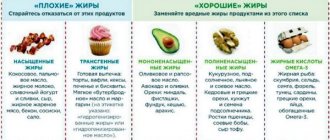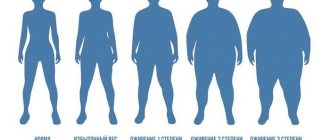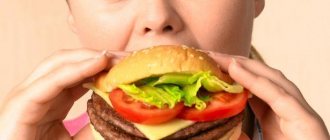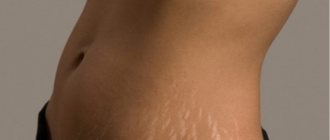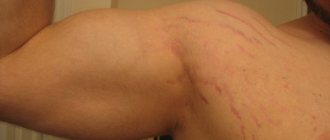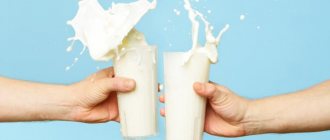When we say “you need to get in shape,” we usually mean two processes: toning muscles and getting rid of fat. Now I want to touch on the second topic. I have already written in detail about how to train to get rid of fat, but now I want to draw your attention to the fact that the fat in our body is different. This is why in some places we manage to “lose weight” faster, while in others (they are often called places where problematic fat accumulates - for example, fat on the thighs of girls) this process is very slow and requires a lot of effort.
Visceral fat is not everything...
The human body is designed in such a way that everything in it is interconnected and interacts with each other. The fat layer is part of the endocrine system. During menopause, it begins to produce sex hormones, partially performing the function of the ovaries. Thus, it prevents the occurrence of osteoporosis (brittle bones due to loss of calcium) and fractures associated with it in women. Adipose tissue secretes many important biological substances and hormones: leptin, resistin, adiponectin and many others. Their capabilities have not yet been fully explored.
Without adipose tissue, a person cannot exist because it is necessary for reproduction, bearing a child and feeding him, for controlling the energy balance of the body, thermal insulation and mechanical protection of organs. Important metabolic processes take place in it, it serves as a water storage (when fat breaks down, water is released). There are genetic abnormalities when the body does not have this tissue. In the past, these people most often died. But modern medicine provides them with life support.
Official medicine today distinguishes 5 types of fat in the human body, let’s look at each of them.
What are fats responsible for in the body?
Fat is used for the following purposes:
- hormone production;
- formation of nervous tissue;
- creation of cell membranes;
- construction of skin and other organs;
- participation in biochemical reactions - for example, the absorption of fat-soluble vitamins A, E, K and D.
From the above, it clearly follows that the problem of excess weight in women after 40 years of age should be approached with the utmost caution. Adipose tissue is capable of synthesizing female sex hormones (so-called extragonadal synthesis). This feature is found only in primates - humans and monkeys. An additional source of hormones can soften the course of menopause, reduce the leaching of calcium from bones, and reduce the risk of cancer.
Korolkova T.N., Poliychuk T.P. Department of Medical Cosmetology, St. Petersburg Medical Academy of Postgraduate Education. Collection of articles of the Scientific and Practical Society of Cosmetologists of St. Petersburg, issue 3. “Adipose tissue is an element of the reproductive system of the body. For men of all ages, as well as girls before puberty (puberty - B.N.) and older women, this is the most important source of female sex hormones.”
Nature has been polishing adaptation mechanisms for many millions of years, and the fashion for being slim should not overshadow common sense and harm health.
White fat
When people mention fat, they immediately associate it with this type of adipose tissue. It consists of adipocytes. The color is white or with a yellow tint because it has few blood vessels and mitochondria that produce energy. It is precisely to reduce the concentration of adipocytes that procedures such as cryolipolysis, massage, and wraps are aimed at reducing the amount of white fat.

The task of white fat is to conserve energy and produce biologically active substances. The adiponectin it produces reduces the likelihood of diabetes by 79% and various heart diseases due to the fact that it increases sensitivity to insulin. With a large gain of weight, its production slows down or stops altogether. And then the development of various diseases is possible.
How to control white fat
Leptin, secreted by white fat, is responsible for appetite and hunger. However, one should not conclude that there should be a lot of white fat. If its presence in the body increases greatly, it will lead to leptin resistance. Which will cause an unrelenting feeling of hunger and a gain of extra pounds, this can lead to a disease such as compulsive overeating, details here...
Indicators of normal body fat content for men are 15-25%, for women - 15-30%. Everything above suggests that it’s time to play sports and pay attention to your diet.
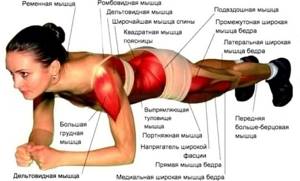
The white fat layer is located under the skin and around the internal organs. Serves to store energy during the absence of food.
What does a fat cell consist of?
I have already indirectly touched upon in articles on my blog that the fat in our body is heterogeneous.
First, I will show you what a fat cell (adipocyte) looks like.

An adipocyte is a cell that primarily makes up adipose tissue.
Adipocytes participate in fat metabolism and accumulate fats, which can later be used for energy production.
An adipocyte can completely use up the “fat drop” (triglycerides) inside itself, but the NUMBER OF ADIPOCYTES DOES NOT BECOME LESS.
The fat cell itself and its core, naturally, do not burn. The number of fat cells remains the same, regardless of the volume of their internal filling.
What do I mean... You don’t lose weight by REDUCING THE NUMBER of fat cells in the body, you lose weight by REDUCING THE NUMBER OF TRIGLYCERIDES IN FAT CELLS (i.e. the fat cell becomes less filled with triglycerides).
But if, after losing weight, you again start “eating like crazy,” then the fat cells will again swell with triglycerides and swell, which will make you look like a candy bar again.
So, let's take a closer look at the fat cell:
- The nucleus contains DNA (controls cell processes, accumulates information).
- Membrane is the cell membrane (protects the internal environment).
- Cytoplasm is mainly water + glucose + amino acids. Constantly on the move. All cellular metabolism occurs in it.
- Mitochondria is the powerhouse of the cell.
- Golgi complex (apparatus) - sorts substances, glucosylates fats and sends them for export (for example, to muscles during lipolysis). This is a kind of packer inside the cell.
- The fat reservoir (or fat drop) is, in fact, the main content of the fat cell, which consists of triglycerides (fats). The volume of fats inside the cell can decrease or increase.
Adipocytes are very plastic. Their size can be increased up to 25 times! Moreover, the longer a person stays in a fatty body, the more the adipocyte “remembers” this stretched state and it becomes more difficult to return to its previous state.
Brown fat
It is also called brown. It is an antagonist of white fat. It helps produce energy. Its properties and color depend on its tight connection with mitochondria. If you make it active, it will begin to burn white. Many scientists tend to consider brown fat to be muscle tissue rather than fat.
Studies have shown that thin people have more brown fat than overweight people. In newborns, its amount can be 5% of body weight, which helps protect the child from hypothermia, thanks to the ability of adipose tissue to produce heat, which is called thermogenesis. There is not very much of this type of fat in the body of any person. If a person weighs 68 kg and has 20-30 kg of fat, then there will be only 500-800 g of brown fat. And this amount is enough to burn 300-500 cal/day. This allows you to lose 450 g of weight per week.

Currently, a drug is being developed that affects the activation of brown fat. It will be used to treat obesity. However, this does not mean that you should forget about monitoring your eating behavior and active physical activity.
This good fat is located on the back of the neck, back, shoulders and chest. It contains many vessels and contains iron, which gives it a specific color. This is how it differs from white fat. Increasing the amount of brown fat speeds up metabolism and increases energy consumption, which allows you to maintain normal weight. But this can be done in one way - hardening the body from childhood. Brown fat, which has the ability of thermogenesis, helps you lose weight.
Learn everything about the composition of human fat to get rid of it forever!

Fat is a rather complex component that is present in every body. Most of it comes from food. The article describes what human fat consists of and what functions it performs.
Fat enters the human body from food; most lipids and fats are formed from carbohydrates and proteins. In a healthy person, fat accounts for 10-20%. And in the case of obesity, this figure increases significantly.
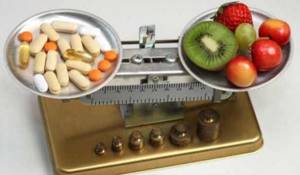
After the fat is absorbed, it spreads to all tissues and organs. The composition of fat is directly determined by the food a person eats.
What does human fat consist of, what are its components? If a person has been eating one type of fat for a long time, then the fat accumulated in the body will be similar in properties to food fat. Excess fat acts as a source of energy; these storage facilities are activated during fasting, hypothermia, and stress. With intensive nutrition of fats and carbohydrates, they are deposited in fiber, omentum, and loose connective tissue around organs. During prolonged physical activity, up to 80% of energy is released precisely due to the burning and oxidation of fats. Fatty deposits are broken down into fatty acids and glycerol by lipase. Fatty acids are converted to carbon dioxide and water. This process releases a large amount of energy. Part of the reserves is absorbed into the blood, where, under the influence of enzymes, it is also broken down into glycerol and fatty acids. Once in the liver, these compounds are converted into glycogen.

Fish oil and vegetable oil are absorbed in the body by 98%, but animal oil by only 90%. Vegetable fats are a source of lipids. If a person does heavy physical work every day, then he needs to consume about 165 grams per day. fat If there is no load, 100 g is enough. At the same time, 75% of this indicator should be animal fats, the rest - fats of vegetable origin.
Excessive fat content in the blood or body leads to serious illnesses and shortens life span. This is especially dangerous for older people. Excessive consumption of fatty foods complicates the digestion process and reduces performance by almost half.

The following groups of lipoids enter the body with food: phosphatides and sterols. You need to get up to 10 grams per day. phosphatides and up to 1.5 g. sterols Fats of the first group are found in unrefined sunflower oil, butter and eggs. A prominent representative of the second group is cholesterol. The amount of cholesterol in the body is negligible, about 0.2%, but this figure can increase with poor nutrition. It is found in foods of animal origin and is absent in plant foods.
Human fat includes both saturated (stearic, butyric) and unsaturated fatty acids (oleic, linoleic). The latter acids enter the body with goose fat and vegetable oils (hemp, sunflower). Lack of unsaturated acids in the body leads to an increase in cholesterol levels in the blood, atherosclerosis appears, which entails myocardial infarction, and blood vessels become less elastic. It is necessary that the body receives at least 1% of the total calorie content of food per day from unsaturated acids.

Fat in the body plays the role of a battery. 1 gram of fat is 9 kcal. 30% of the energy value of food consumed per day is allocated to fat. If energy expenditure exceeds the number of calories from the diet, then fat deposits come to the rescue. They allow you to not feel hungry for longer. With fatty foods, vitamins A, B, C and essential fatty acids enter the body. These acids play an important role in the functioning of the entire human body. They are responsible for the condition of nails and hair, prevent the formation of blood clots, are necessary for candidiasis, improve brain function, and normalize blood pressure.
Fat is a direct participant in the metabolic process, a keeper of antioxidants, helps resist various infections and improves immunity.
In the process of losing weight, it is impossible to get rid of all fat. There is even a scale of normal fat tissue in the body. Each age has its own indicator, deviations from which are fraught with consequences. Fat mass is simply necessary for normal hormonal balance and metabolism. It is important to know information about subcutaneous fat content. Its excess leads to various kinds of disorders. It can put pressure on organs, the spine, and put additional stress on the joints. Excess fat is a source of increased waste and toxins in the body. The abdominal cavity is where excess fat accumulates. It can be seen with the naked eye. Big belly - shows the degree of obesity. Before you start losing weight, you should study your body thoroughly. It is important to know about the metabolic rate. The lower it is, the greater the likelihood of obesity. Knowing this information, you can calculate the number of calories that are allowed per day. It is important to take into account a person’s daily activity and energy expenditure. Based on knowledge about the body and the processes in it, a nutritionist and fitness instructor will select an appropriate weight loss program so that fat cells are broken down to produce energy. This approach to losing excess weight is correct and will definitely bring the desired result.
There is such a thing as reducing body fat mass. This means reducing the percentage of body fat. Spot reduction allows you to remove fat deposits in those places that concern you most. This technique allows women to maintain ample breasts and rounded hips after losing weight, but deposits in the abdominal area will disappear.
While losing weight, it is important to stay healthy. Incorrect methods of losing excess weight lead to numerous diseases. Therefore, you should be extremely careful in the pursuit of beauty.
Beige fat
It is believed that this type is formed from a unique type of cells and is a combination of white and brown fats. It has been established that white fat sometimes turns into beige fat. This ability can come in handy in the battle against excess weight. Experiments have shown that hormones released during stress and colds can convert white fat into beige fat. Systematic exercise also contributes to this transformation. The muscles begin to secrete specific proteins, and they turn on this reaction. Beige fat quickly burns fat deposits, which prevents you from gaining excess weight.

HEALTHY FOOD PRODUCTS
Beige fat is considered a transitional form, which under the right conditions can become both white and brown fat. Moreover, it will turn brown if the body is exposed to low temperatures. Beige fat has not yet been studied enough because it was recently discovered.
Subcutaneous fat
This type of fat is located under the skin and makes up 90% of the total fat. Its ratio is measured with special instruments. To lower its level, the following techniques help: reducing the consumption of foods high in sugar; Constantly doing intense exercise.

Functions of subcutaneous fat:
- hormone production;
- shock absorption and protection of internal organs;
- energy deposition;
- necessary for bearing a child and breastfeeding.
In women and lovers of unhealthy eating, this fat accumulates very quickly and getting rid of its excess is not easy. Also, its amount increases with age, and begins to decrease in old age. Dietary preferences also affect the rate of accumulation. With a sedentary lifestyle and overeating, its amount increases rapidly. Excessive fat deposits on the hips lead to disorders in the reproductive system and varicose veins.
Subcutaneous fat is considered the culprit for the appearance of cellulite. These are not very aesthetic, but natural changes in the structure of subcutaneous fat that do not require treatment. Its appearance depends on the production of estrogens and progestins. The absence of cellulite indicates that a woman’s body produces a lot of androgens. Cellulite is a gender characteristic of women.
Why does the body need fat?
Fat enters the body with food. Carbohydrates and proteins can also be converted into fat if they are supplied in quantities exceeding the body’s current needs. That is, almost any food(!) can become fat if the incoming energy is not fully consumed.
Due to increased advertising, ordinary consumers have the impression that fat is generally bad, always and everywhere: in milk, yogurt, and especially in fat folds. In fact, this is not entirely true, and fat performs many irreplaceable functions in the body. Some jokingly call their deposits “strategic reserves.”
If you overindulge in food, the deposited fat turns from “rainy day reserves” into a “waste disposal site.” And when cellulite appears, it is almost impossible to achieve fat breakdown using simple methods - food restrictions, increased physical activity. In principle, fat deposition occurs much easier than breakdown, even with cellulite.
Visceral fat - what is it?
Visceral fat is considered harmful to humans. This is internal fat that is deposited around the abdominal organs and interferes with their proper functioning.
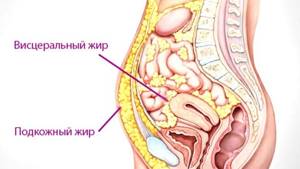
This fat has been found to produce retinol binding protein 4, which can increase insulin resistance, which can cause type 2 diabetes.
Excess visceral fat can provoke the occurrence of cancer pathologies, cardiovascular diseases, and dementia. The connection between dementia and the presence of excess fat has not been fully explored. American scientists suggest that the problem may be leptin, which is secreted by white adipose tissue and negatively affects the brain. Data from more than 6,500 patients were analyzed to study the connection between body fat and dementia.
To find out the amount of harmful visceral fat, you need to calculate your waist-to-hip ratio. To do this, measure the circumference of the waist and hips. Then divide the result of the waist circumference by the hip circumference. If the figure is more than 1.0 for men and 0.85 for women, then the body fat indicator is exceeded. You can also try to pull in your stomach; if you have a high content of internal fat, you won’t be able to do this.

How to hide your belly with clothes?

Until the problem of how to deal with age-related fat has not been radically solved, you can try to hide a big belly with clothes. To do this, things are chosen taking into account the following recommendations:
- you need to choose a fabric that is dense, but which will not create additional volume;
- It is better not to use pink, peach shades;
- light inserts in the problem area are prohibited;
- the silhouette should visually expand downwards;
- It is better to avoid large patterns on fabric;
- in the area of the armpits on the chest there should be no frills or pre-gathered fabric - this visually increases the silhouette;
- among trousers, it is better to choose high-waisted jeans;
- It is better to wear the top part untucked rather than tucked into trousers.
Coping with the problem of excess weight is difficult after 50. Women's physiology is such that there is a layer of fat in the abdominal area, which becomes more and more difficult to get rid of every year due to a slowing metabolism. But if you think through your diet and physical activity regimen correctly, the problem can be solved.
How to get rid of visceral fat
To reduce internal fat deposits, nutritionists advise increasing the consumption of protein foods and fiber, limiting sweets, eating smaller meals, and arranging fasting days. This is also facilitated by healthy sleep for 8 hours and physical activity. Cardio training will be effective
Excess abdominal fat is a warning sign. An excess of visceral fat leads to increased cholesterol . It enters the circulatory system, spreads throughout the body and causes the development of atherosclerosis, obesity of internal organs, heart attacks and strokes. Gout, fatty hepatosis and other pathological changes may appear.
If you follow the principles of a healthy diet, exercise and lead an active lifestyle, you can easily get rid of “dangerous” fat.
To find out how much visceral fat is in the body, you need to measure your waist circumference. The normal figure for women is no more than 82 cm, for men - no higher than 94 cm. A significant increase in these indicators indicates that you already have excess “bad” fat, and this is a reason to think about your health.
How to get rid of fat at home?

It is quite possible to cope with unpleasant features of the figure at home without resorting to the help of specialists. To do this you need:
- to live an active lifestyle. It's not just about the gym. You need to walk and swim more;
- avoid stress;
- get enough sleep;
- eat a balanced diet. Minimize the amount of protein consumed, eliminate fast carbohydrates;
- supplement the personal care procedure with cosmetic treatments (peeling, masks, wraps).
Changing your diet
It is important to remember that without proper nutrition you will not be able to cope with excess weight. The rules for how to deal with age-related fat after 40 are significantly different from the diet at 20 years old. The reason is a slower metabolism and less calorie consumption. Often at 40 years old you need almost 2 times less calories than at 18-25.
A diet for burning fat at this age includes:
- refusal of fatty, sweet, starchy foods, especially cookies, gingerbreads and other fast carbohydrates;
- sweets are abandoned in favor of fruits;
- introduction of fiber and fermented milk products into the diet;
- drink at least 1.5 liters of clean water per day;
- per day you need to eat 5 times in small portions, the last meal – 3 hours before meals;
- You need to eat for at least 20 minutes, chewing food thoroughly;
- Once a week you need a fasting day.
Losing excess weight with this diet is not difficult. But in order to see the result, you need to stick to it constantly. Only occasionally is it allowed to eat unhealthy foods to pamper yourself and lift your spirits.


